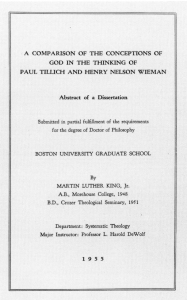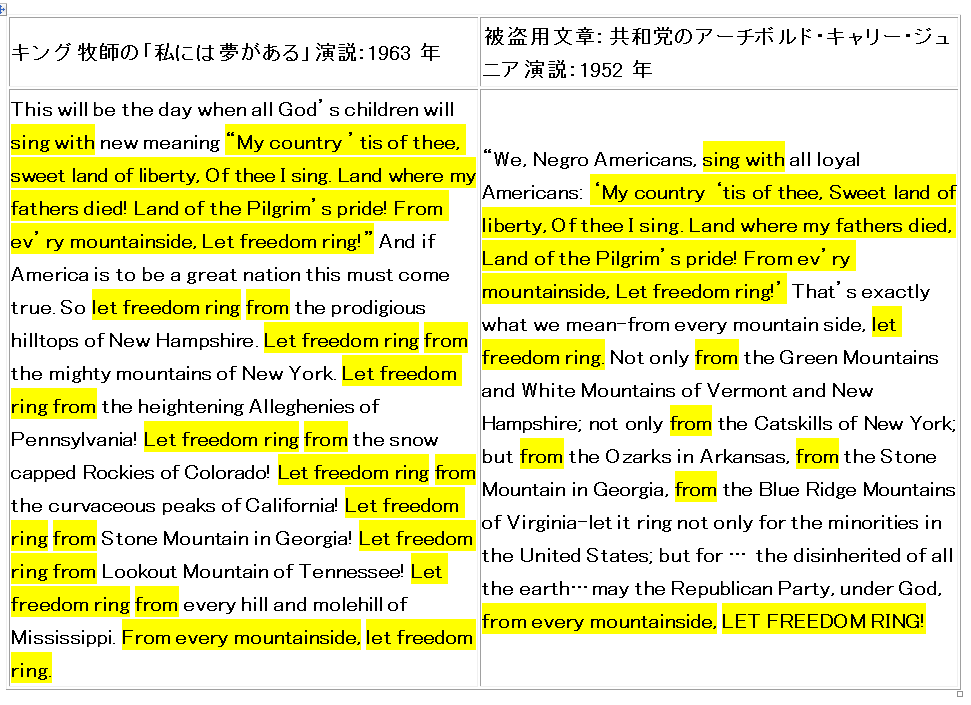2017年9月6日掲載。
ワンポイント:キング牧師(男性)は、1964年にノーベル平和賞を受賞した米国の人種差別運動のヒーローで、1968年4月4日(39歳)に暗殺された。1955年、ボストン大学で宗教学の研究博士号(PhD)を取得したが、1991年(没後23年、取得後36年)、盗博が発覚した。盗用文字率は約52%(推定)と多いが、ボストン大学は博士号をはく奪しなかった。損害額の総額(推定)は5000万円。キング牧師事件は、「全期間ランキング」の2か所で取り上げられた。
ーーーーーーー
目次(クリックすると内部リンク先に飛びます)
1.概略
2.経歴と経過
3.動画
4.日本語の解説
5.不正発覚の経緯と内容
6.博士論文の盗用解析
7.白楽の感想
8.主要情報源
9.コメント
ーーーーーーー
●1.【概略】
 マーティン・ルーサー・キング・ジュニア(Martin Luther King Jr.、写真出典)を本記事ではキング牧師と呼ぶ。また、キング牧師は有名人なので、全体的な情報量は多い。本記事では盗博を中心に記述する。
マーティン・ルーサー・キング・ジュニア(Martin Luther King Jr.、写真出典)を本記事ではキング牧師と呼ぶ。また、キング牧師は有名人なので、全体的な情報量は多い。本記事では盗博を中心に記述する。
キング牧師は、「I Have a Dream」(私には夢がある)で知られる有名な演説を行った人物。1964年のノーベル平和賞受賞者。2004年の議会名誉黄金勲章受章者。アメリカの人種差別(特にアフリカ系アメリカ人に対する差別)の歴史を語る上で重要な人物の一人である。(マーティン・ルーサー・キング・ジュニア – Wikipedia)
1955年、ボストン大学で宗教学の研究博士号(PhD)を取得した。
1964年(35歳)にノーベル平和賞を受賞し、米国の人種差別運動のヒーローである。
1968年4月4日(39歳)、 ジェームズ・アール・レイに暗殺された
1991年(没後23年)、36年前に取得した博士号での盗博が発覚した。
キング牧師事件は、「全期間ランキング」の「Insider Monkeyの「全期間の盗用11大スキャンダル」:2016年8月22日」の第9位、同「Toptenz.netの「有名人の10大盗用」:2016年1月28日」の第3位である。
 ボストン大学(Boston University)。写真出典
ボストン大学(Boston University)。写真出典
- 国:米国
- 成長国:米国
- 研究博士号(PhD)取得:ボストン大学
- 男女:男性
- 生年月日:1929年1月15日
- 没年月日:1968年4月4日。享年39歳
- 分野:宗教学
- 博士論文タイトル:A Comparison of the Conceptions of God in the Thinking of Paul Tillich and Henry Nelson Wieman.
(日本語訳):パウル・ティリッヒとヘンリー・ネルソン・ワイマンの思想における神の概念の比較 - 博士論文指導教授:
- 博士論文提出:1955年(26歳)
- 盗博発覚年月日:1991年(没後23年)
- 盗用ページ率:80~90%(白楽の乱暴な推定)
- 盗用文字率:約52%(キング牧師論文プロジェクトが算出した第2章の盗用率)
- 研究博士号(PhD)はく奪状況:はく奪なし
- 発覚時地位:死亡者、ノーベル平和賞受賞者
- ステップ1(発覚):第一次追及者はスタンフォード大学・「キング牧師論文プロジェクト」の係員(詳細不明)
- ステップ2(メディア):サンデー・テレグラフ(Sunday Telegraph)紙のフランク・ジョンソン(Frank Johnson)記者
- ステップ3(調査・処分、当局:オーソリティ):①ボストン大学・調査委員会。②サンデー・テレグラフ(Sunday Telegraph)紙。③キング牧師を研究する研究者
- 大学・調査報告書のウェブ上での公表:なし
- 不正:盗博
- 時期:人生の初期から
- 損害額:総額(推定)は5千万円。没後23年の発覚で、職・地位として学術界のキャリアがなく職務上の損害はない。研究費は受給してない。⑤調査経費(大学と新聞社や研究者)が5千万円。
- 結末:
●2.【経歴と経過】
- 1929年1月15日:ジョージア州アトランタで生まれる
- 1948年(19歳):モアハウス大学(Christian Medical College & Hospital)を卒業。社会学
- 1951年(22歳):クローザー神学校(Crozer Theological Seminary)終了。神学士(Bachelor of Divinity)
- 1953年6月18日(24歳):26歳のコレッタ・スコット(Coretta Scott)と結婚
- 1955年(26歳):ボストン大学(Boston University)で神学の研究博士号(PhD)を取得
- 1963年8月(34歳):ワシントン大行進にて、“I Have a Dream”の演説を行う
- 1964年(35歳):ノーベル平和賞受賞
- 1968年4月4日(39歳): ジェームズ・アール・レイに暗殺される
- 1991年(没後23年):盗博が発覚
●3.【動画】
【動画】
盗博ではなく有名な演説も盗用していたという証拠と解説。「キング牧師の「私には夢がある」演説は共和党のアーチボルド・キャリー・ジュニア演説の盗用だった(MLK Plagiarized “I Have a Dream” Speech from Republican Archibald Carey Jr.) 」(英語)2分32秒
Gadfly Productions が2016/07/21 に公開
以下のリンクが切れた時 → 保存版
https://www.youtube.com/watch?v=1-yI7QF5BHg
●4.【日本語の解説】
★2010年?:木内裕也「アトランタ出張」
キング牧師にはあまり知られていない過去もあるのです。たとえば、彼はボストン大学の神学部で博士号を取得しましたが、彼の博士論文や、大学院で執筆した論文の数々は他の人の論文の記述を盗用した箇所がたくさんあります。
●5.【不正発覚の経緯と内容】
 キング牧師(写真出典)は、1955年(26歳)、343頁の博士論文をボストン大学(Boston University)に提出し、神学の研究博士号(PhD)を取得した。
キング牧師(写真出典)は、1955年(26歳)、343頁の博士論文をボストン大学(Boston University)に提出し、神学の研究博士号(PhD)を取得した。
1964年(35歳)にノーベル平和賞を受賞したが、1968年4月4日(39歳)、 ジェームズ・アール・レイに暗殺された。
1986年(没後18年)、キング牧師の妻のコレッタ・キングが、キング牧師の博士論文をスタンフォード大学・「キング牧師研究教育機関(The Martin Luther King, Jr. Research and Education Institute)」の「キング牧師論文プロジェクト(King Papers Project)」に寄贈した。
1987年(没後19年)、キング牧師の博士論文を整理していた「キング牧師論文プロジェクト」の係員が、文章の盗用に気が付いた。
1989年10月(没後21年)、「キング牧師研究教育機関」の所員は、コレッタ・キングを交え、アトランタで、キング牧師の盗博を議論したが、コレッタ・キングは意見を表明しなかった。
1989年12月3日(没後21年)、サンデー・テレグラフ(Sunday Telegraph)紙のフランク・ジョンソン(Frank Johnson)記者がキング牧師の盗博事件を最初に報道した。見出しは「キング牧師は盗用者?(”Martin Luther King—Was He a Plagiarist?”)」だった。
しかし、主要な新聞はこの記事を無視した。
1990年1月22日(没後21年)、スポットライト(The Spotlight)紙がサンデー・テレグラフ紙の記事をベースに記事を掲載した。
やがて、各紙が報道するようになった。
1990年(没後21年)、ボストン大学は4人の委員からなる調査委員会を設置した。
1991年10月(没後23年)、ボストン大学・調査委員会はキング牧師の博士論文は盗博だったと発表した。それにもかかわらず、委員会は、「キング牧師の博士号のはく奪を考えるべきではない」と付け加えた。
1991年10月10日(没後23年)、ボストン大学のジョン・ウェストリング・学長(Jon Westling)は、調査委員会の提案を受け入れると発表した。
委員の1人であるジョン・カートライト社会倫理学・教授(John Cartwright)は、「キング牧師の博士論文は複数の他人の文献を適切に引用していませんでした。ただ、委員会はその理由を推測しませんでした」と述べた。
★博士論文以外の盗用
研究者ではないので、盗博以外は本ブログの守備範囲外だが、なぜ盗用をしたのかを考えるのに有用なので、盗博以外の盗用の分析も少し加える。
キング牧師は博士論文だけ盗用したのではない。学術的でない文章や演説では、むしろ、頻繁に盗用していた。キング牧師は長年に渡り盗用していた盗用常習犯で、いわば、盗用は彼の文章・演説スタイルの一部だった。
→ 2004年12月21日のラルフ・ルーカー(Ralph E. Luker)のブログ記事:History News Network | On Martin Luther King’s Plagiarism …、(保存版)
1963年8月(34歳)、ワシントン大行進で有名な“I Have a Dream”の演説を行なった(写真出典)。
この有名な「私には夢がある(I Have A Dream)」演説(以下の左欄)も、共和党のアーチボルド・キャリー・ジュニア演説(下の右欄)の盗用だった。 → 以下の演説文章の出典:https://www.youtube.com/watch?v=1-yI7QF5BHg
最初の3分の1は、ほぼ逐語盗用である。後半の3分の2は、キング牧師は「Let freedom ring from」の「from」の後の地名を変えただけである。被盗用演説では「Let freedom ring from」の「Let freedom ring」を省いて「from」にしたが、構文は同じである。
典型的な盗用である。
●6.【博士論文の盗用解析】
 キング牧師(Jennifer Moore)の博士論文のタイトルは 「A Comparison of the Conceptions of God in the Thinking of Paul Tillich and Henry Nelson Wieman」。
キング牧師(Jennifer Moore)の博士論文のタイトルは 「A Comparison of the Conceptions of God in the Thinking of Paul Tillich and Henry Nelson Wieman」。
日本語訳は、 「パウル・ティリッヒとヘンリー・ネルソン・ワイマンの思想における神の概念の比較」である。
博士論文(右出典不明)は6章構成で、343ページ。
ボストン大学・調査委員会は、博士論文の前半の45%と後半の21%を盗用していたと発表したが、盗用ページ率と盗用文字率に分けて盗用率を算出していない。
しかし、別の記事に、盗用はもっと大きいと書いてある。
ボストン大学は事実を歪曲し過少に発表したのである。盗用率の数値は不正確だと指摘されている。
6章構成の第2章の盗用率(盗用文字率?)は、1991年にキング牧師論文プロジェクト(King Papers Project)が52%と試算した。この52%を全体の盗用文字率としておこう。
★盗用解析1:逐語盗用
カナダのブリティッシュコロンビア大学(University of British Columbia)の生物学科教員が作った盗用防止教材(2004-2005年版)に、キング牧師の文章を逐語盗用の例として示している。
→ 出典:PLAGIARISM brochure(保存済)
→ 原典:Becoming Martin Luther King — Plagiarism and Originality: A Round Table,” Journal of American History (June 1991, pp. 11-123. The example used below is on p. 25.
キング牧師の文章(下の左欄)、被盗用用(下の右欄)。黄色は同じ文字群。
まるっきり逐語盗用である。
★盗用解析2:第3章
以下に、キング牧師の博士論文の第3章の盗用を指摘した文章を貼り付ける(出典:http://web.archive.org/web/20060826103832/http://chem-gharbison.unl.edu:80/mlk/ch3.html)。赤字の文章が盗用文章である。赤字の文章クリックすると、原典のリストがズラズラと示される。
【 長いので注意】。長いので、全部引用しない。それでも長い。
――――――――
Chapter III
TILLICH’S CONCEPTION OF GOD
1. The question of being
It is impossible to understand Tillich’s conception of God without a prior knowledge of his ontology as a whole, since it is his ultimate position that “God is being-itself.” To attempt to understand Tillich’s conception of God without an understanding of his conception of being is like trying to understand the humanistic conception of God without understanding its conception of man. So we may well begin our study with a discussion of Tillich’s ontological position.
Tillich insists that the core of philosophy is the ontological question, and this ontological question is logically prior to every other. Thought must start with being; it cannot go behind it. Ontology is possible because there are concepts less universal than “being,” but more universal than the concepts that designate a particular realm of beings. Such ontological concepts have been called “principles,” “categories” or ultimate notions.* Tillich’s analysis of these concepts is the very heart of his philosophy.
These concepts, he holds, are strictly a priori.They are necessary conditions for experience itself. They are present whenever something is experienced , and hence constitute the very structure of experience. Tillich makes it emphatically clear that this does not mean that the concepts are known prior to experience; on the contrary, “they are products of a critical analysis of experience.”†
Taken seriously this Kantian language implies that the “‘being” to be analyzed is to be found only in the knower, and not, except derivatively, in the known. But this is exactly what Tillich seems to be denying, for he says thatthe structure of experience is discovered in experience, by analysis. In other words Tillich’s language implies the Kantian critical philosophy, while his analysis implies an epistemological realism.*
Tillich distinguishes four levels of ontological concepts: (1) the basic ontological structure; (2) the “elements” constituting that structure; (3) the characteristics or being which are the conditions of existence, or “existential being;” and (4) the categories of being and knowing. We shall discuss each of these in order.
i. The basic ontological structure
(1) Man, self and world
Being a self means that man is both subject and object. He is a subject in the sense that he is so separated from everything as to be able to look at it and act upon it. He is object in the sense that he so belongs to the world, that he is an intimate part of the process. But each factor determines the other. It is wrong to assume that the environment wholly explains behavior.
The mistake of all theories which explain the behavior of a being in terms of environment alone is that they fail to explain the special character of the environment in terms of the special character of the being which has such an environment. Self and environment determine each other.
(2) The logical and the ontological object
Within the self-world polarity are to be found the derivative polarities of objective and subjective reason, of logical object and subject. Pure objects, “things,” are completely conditioned or bedingt by the scheme of knowing. But man himself is not a “thing” or merely an object. He is a self and therefore a bearer of subjectivity. He is never bound completely to an environment.
He always transcends it by grasping and shaping it according to universal norms and ideas …. This is the reason why ontology cannot begin with things and try to derive the structure of reality from them. That which is completely conditioned, which has no selfhood and subjectivity, cannot explain self and subject ….It is just as impossible to derive the subject from the object This trick of deductive idealism is the precise counterpart of the trick of reductive naturalism …. The relation is one of polarity. The basic ontological structure cannot be derived. It must be accepted.*
ii. The ontological elements
The second level of ontological analysis deals with those “ontological elements” which constitute the basic structure of being. Unlike the categories, these elements are polar: each is meaningful only in relation to its opposite pole. “One can imagine a realm of nature beside or outside the realm of history, but there is no realm of dynamics without form or of individuality without universality.” ‡ There are three outstanding pairs which constitute the basic ontological structure; individuality and universality, dynamics and form, freedom and destiny. Each of these distinctions is discovered in the self’s experience of the world, and then generalized for all interactions within being. The first element in each of these polarities expresses the “self-relatedness of being,” i.e., its power of being something for itself. The second element expresses the “belongingness of being,” i.e., its character of being a part of a universe of being.*
(1) Individuality and participation
Individualization is a quality of everything that exists; “it is implied in and constitutive of every self, which means that at least in an analogous way it is implied in and constitutive of every being.”† To be a self is to be an individual. Selfhood and individualization may be different conceptually, but they are inseparable actually.‡ To be is to be an individual. But man’s individualization is not absolute or complete . It gains meaning only in its polar relation with participation. Leibniz emphasizes this point when he speaks of the microcosmic structure of the monad.§ Whitehead sets it forth when he speaks of the “prehension” of the whole by the actual occasion. Martin Buber emphasizes this role of participation in the process of individualization when he sets forth the role of the “thou” in the development of the “I”. Each of these thinkers gives backing to what Tillich is attempting to say, namely, that individuation implies participation. Man participates in the universe through the rational structure of mind and reality. When individualization reaches the perfect form we call a “person,” participation reaches the perfect form we call “communion.” Persons become persons only by participating in society. It is only in the communion of personal encounter that persons can grow. Participation is essential for the individual “Without individualization nothing would exist to be related. Without participation the category of relation would have no basis in reality.’*
It is clear from the foregoing that Tillich is not interested in slanting such statements either in the idealistic or in the naturalistic direction. But it is especially important to recognize that he does not regard them as being derived from empirical observation concerning contingent facts. Rather, he conceives of individualization and participation as ontological elements which, in the course of a critical analysis of experience, reveal themselves to be a priori in the sense that experience could not be what it is unless it occurred within them. The reciprocal relationship between “personal” and “communal”-for example, one cannot become fully a self except in relation with other selves-is a structural characteristic of being. In the polarity of individualization and participation Tillich finds a solution to the endless problem of nominalism and realism. Individuals are real, but they participate in the universal structure, which, however, is not some sort of second reality lying behind empirical reality.†
●7.【白楽の感想】
《1》博士号はく奪!
キング牧師の盗博は没後に発覚した。キング牧師はノーベル平和賞を受賞した世界の偉人である。
例えそうであっても、盗博なのだから、ボストン大学は博士号をはく奪すべきだった。盗博に博士号は授与できない。これが原則でしょう。
標語:「盗博の博士号は当然はく奪!」
なお、ボストン大学・調査委員会はキング牧師をかばおうと、盗用率を低く算出したと指摘されている。政治的動機だそうだ。真実に対するナンタル冒涜!
真実を最も尊いとする思想がないのか?
●8.【主要情報源】
① ウィキペディア英語版:Martin Luther King Jr. authorship issues – Wikipedia
② ウィキペディア英語版:Martin Luther King Jr. – Wikipedia
③ 1991年10月11日の「NYTimes」記事:Boston U. Panel Finds Plagiarism by Dr. King – NYTimes.com、(保存版)
④ キング牧師盗用サイト:Martin Luther King Plagiarism Page
★記事中の画像は、出典を記載していない場合も白楽の作品ではありません。
ーーーーーー
ブログランキング参加しています。
1日1回、押してネ。↓
![]()
ーーーーーー
●コメント


